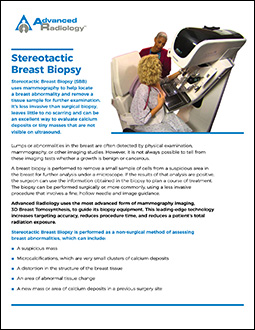Stereotactic Breast Biopsy (SBB) uses mammography to help locate a breast abnormality and remove a tissue sample for further examination. It’s less invasive than surgical biopsy, leaves little to no scarring and can be an excellent way to evaluate calcium deposits or tiny masses that are not visible on ultrasound.
Lumps or abnormalities in the breast are often detected by physical examination, mammography, or other imaging studies. However, it is not always possible to tell from these imaging tests whether a growth is benign or cancerous.
A breast biopsy is performed to remove a small sample of cells from a suspicious area in the breast for further analysis under a microscope. If the results of that analysis are positive, the surgeon can use the information obtained in the biopsy to plan a course of treatment. The biopsy can be performed surgically or, more commonly, using a less invasive procedure that involves a fine, hollow needle and image guidance.
Advanced Radiology uses the most advanced form of mammography imaging,
3D Breast Tomosynthesis, to guide its biopsy equipment. This leading-edge technology increases targeting accuracy, reduces procedure time, and reduces a patient’s total radiation exposure.
Stereotactic Breast Biopsy is performed as a non-surgical method of assessing breast abnormalities, which can include:
- A suspicious mass
- Microcalcifications, which are very small clusters of calcium deposits
- A distortion in the structure of the breast tissue
- An area of abnormal tissue change
- A new mass or area of calcium deposits in a previous surgery site
How Should I Prepare for My Stereotactic Breast Biopsy?
Prior to a needle biopsy, you should report to your doctor any recent illnesses, allergies (especially to anesthesia) or other medical conditions, and all medications that you are currently taking, including herbal supplements. Your physician may advise you to stop taking aspirin, blood thinners, or certain herbal supplements for three to five days before your procedure.
Women should always inform their physician if there is any possibility that they are pregnant. Some procedures using image guidance are typically not performed during pregnancy.
You should not wear deodorant, powder, lotion or perfume under your arms or on your breasts on the day of your exam. You will be asked to remove some of your clothing and to wear a gown during the exam. You will also be asked to remove jewelry, removable dental appliances, eye glasses and any metal objects or clothing that might interfere with the x-ray images.
What Will I Experience During the Exam?
You will be awake during your biopsy and should have little discomfort. Most women report little pain and no scarring on the breast. However, certain patients, including those with dense breast tissue, or abnormalities near the chest wall or behind the nipple may be more sensitive during the procedure.
When you receive the local anesthetic to numb the skin, you will feel a pin prick from the needle followed by a mild stinging sensation from the local anesthetic. The area will become numb within a few seconds. You will likely feel some pressure when the biopsy needle is inserted and during tissue sampling, which is normal.
You must remain very still while the imaging and the biopsy are being performed. As tissue samples are taken, you may hear clicks or buzzing sounds from the sampling instrument. This is normal.
What Will I Experience After the Exam?
If you experience swelling and bruising following your biopsy, you may be instructed to take an over-the-counter pain reliever and to use a cold pack. Temporary bruising is normal. You should contact your physician if you experience excessive swelling, bleeding, drainage, redness or heat in the breast.
If a marker is left inside the breast to mark the location of the biopsied lesion, it will cause no pain, disfigurement or harm. Biopsy markers are MRI compatible and will not activate metal detectors.
You should avoid strenuous activity for at least 24 hours after the biopsy. More detailed post-procedure care instructions designed specifically for you may be provided by your Radiologist.
What Are the Risks and Benefits of Stereotactic Breast Biopsy?
SBB is an excellent way to evaluate calcium deposits or masses that are not visible on ultrasound. There is a small chance that this procedure will not provide the final answer to explain the imaging abnormality.
The procedure is less invasive than surgical biopsy, leaves little or no scarring, and can be performed quickly. The risk of hematoma or infection is extremely slight.
Generally, the procedure is not very painful, and
little recovery time is required. Patients can quickly resume normal activities. No breast defect remains and, unlike surgery, SBB does not distort the breast tissue or make it difficult to read future mammograms.
Compared with open surgical biopsy, the procedure is approximately one-third the cost.
To download this information in PDF format, click the image below…
Stereotactic Breast Biopsy is available at the following Advanced Radiology locations:
Trumbull – Advanced Women’s Imaging Center – 15 Corporate Drive

